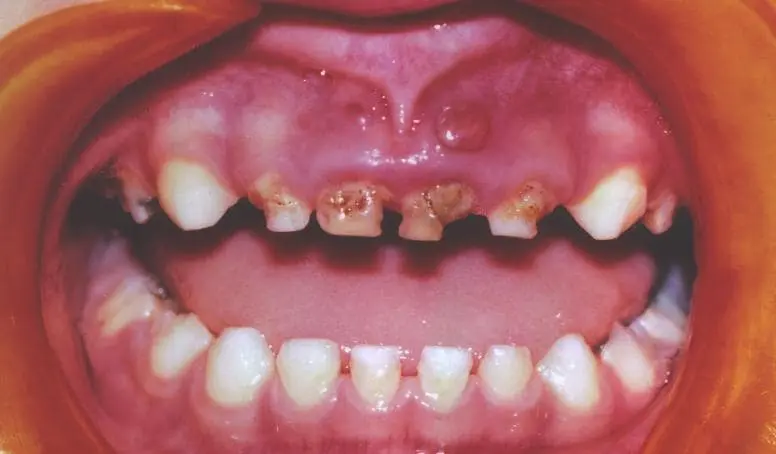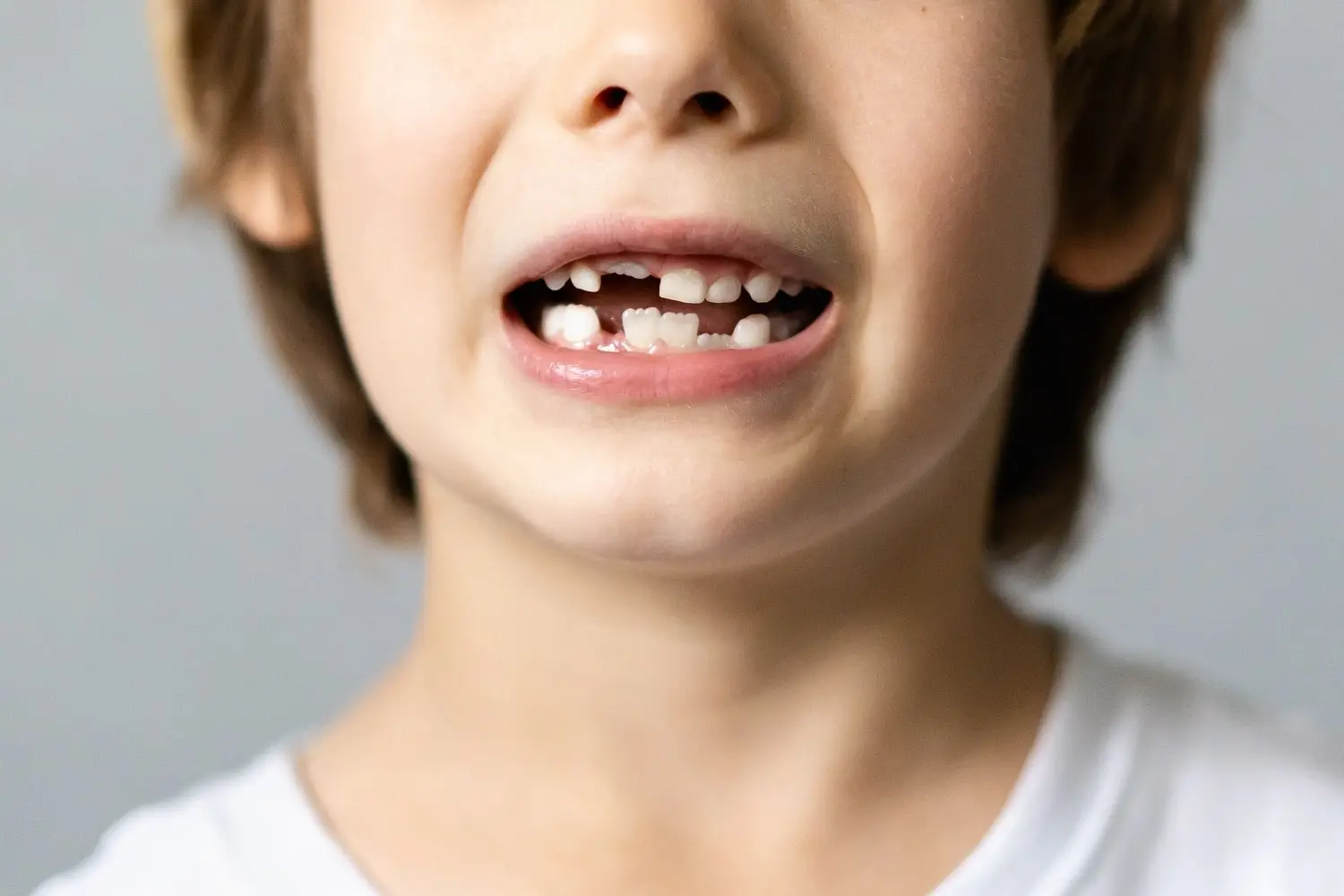Last Updated on: 4th December 2024, 04:35 pm
When we are born, our milk teeth have not yet appeared. However, if lost too soon (shedding when the next tooth comes in), the remaining teeth can move and obstruct the permanent ones. Additionally, treatment to prevent cavities and avoid spaces can be expensive.
What are Dental Caries in Children?
Caries in early childhood is associated with the breakdown or destruction of the dental enamel in milk teeth. The outer surface of the teeth is hard and made of different minerals. Dental caries can be seen as holes in the teeth.
Dental caries in children or early childhood is also called baby bottle or infant caries. This is common, especially in children around 5 years of age. However, it can also start at an earlier age after the eruption of the first teeth (6-12 months of age).

Over the years, this has become a health problem for less affluent populations in toddlers of preschool age throughout the world, both in developed and developing countries. In vulnerable populations due to poverty and malnutrition, it has been estimated that 85% of children develop early childhood caries.
The affected teeth are usually the front ones, but it is possible that in preschool children, it can affect the molars. Initially, white spots may appear near the gumline that are sometimes difficult to see; but if caught early, a cavity may be prevented. If not detected, they can get worse such that yellowish or brown spots begin to appear. Later cavities and broken teeth will require a specific procedure.
What are the Causes of Tooth Decay in Children?
Caries in children have a multifactorial etiology, that is, they can be caused by various factors such as artificial or natural breastfeeding, diet, objects placed in the mouth, sweets and sugars, or carbohydrates. In any of these cases, the microorganisms in the mouth interact with the sugars on the tooth surface, producing acid as a result of metabolism and demineralizing the dental enamel. This generates dental plaque, and with time, tartar, and finally caries.
Genetic factors enter into the formation of tooth enamel. Malnutrition can also affect the state of the teeth along with poor dental hygiene or not having adequate, constant habits that minimize bacterial growth. Added to this is a lack of exposure to fluoride, as this helps fight bacteria and improves enamel.

The condition has been closely associated with children of low-income, migrant, or very poor parents, where social exclusion, socio-cultural differences, beliefs, and education play an important role in the occurrence of caries in early childhood.
However, for children with access to different types of food, where consumption is not controlled and there is a high intake of sugars, soft drinks, sweets, and fruits at inappropriate times along with cereals, bread, or processed carbohydrates, an ideal environment is created for the development and bacterial growth, Poor oral hygiene habits exacerbate the problem.
Symptoms of Dental Caries in a Child
Each child will manifest caries in a different way. It depends on age. To detect a cavity, consider the following:
- White spots begin to form on the teeth in affected areas. These spots mean that the enamel is beginning to break down, which can lead to early tooth sensitivity.
- You may see early decay in the tooth as a light brown color.
- The cavity becomes deeper and turns a darker shade of brown to black.
Symptoms of tooth decay and cavities vary from child to child. Cavities do not always cause symptoms. Sometimes, children don’t know they have a cavity until their dentist finds it. But the child may feel:
- Pain in the area around the tooth.
- Sensitivity to certain foods, such as sweets and hot or cold drinks.
Early Childhood Caries Treatment
The treatment defined by a pediatric dentist or specialist oral health professional will depend upon the symptoms, the severity of the problem, the patient’s age, and general health. Treatments range from preventive when there is not much damage and non-invasive lesions have not yet entered the tooth or the invasion is minimally invasive. There are a lot of options for full restoration that can be carried out if the condition is invasive.

Generally, what is usually required is to remove the decayed part of the tooth and fill it, which helps to repair the damage. This is called restoration.
- Fluoride treatments: during dental visits, a small amount of fluoride may be applied to protect the teeth. In the consultation, the dentist will discern the child’s fluoride requirements and what type of products to use at home to prevent cavities.
- Direct restorations: these are known as fillings placed directly in the cavity in one sitting. Fillings are made of resin and other minerals, usually tooth-colored, and are easy to put on.
- Indirect restorations: these procedures require more than two consultations with a dentist or specialist. They include inlays, onlays, veneers, crowns, and bridges constructed of gold, base metal alloys, ceramics, or composites. Many of these materials resemble natural tooth enamel.
- Root canal treatment: in case the caries are severe and the tooth is infected, this option could save the tooth.
How to Prevent Dental Caries in Early Childhood
After 6 months of age, we can prevent cavities in children. Consider the following useful information:
- It is possible to start as early as pregnancy by taking care of the oral health of the pregnant mother, including her diet while ensuring regular check-ups with a dentist to prevent complications.
- Regardless of whether the mother is breastfeeding or bottle feeding, it is important to take care of the baby’s oral hygiene.
- From birth to 12 months, the baby’s mouth should be gently wiped with a clean, baby wipe and when the first tooth erupts, you can use a baby brush and a drop of fluoride toothpaste, if determined by a pediatric dentist.
- From 12 to 36 months, the teeth should be brushed at least twice a day for 2 minutes, using a small amount of fluoride toothpaste until 3 years of age. It is suggested to brush their teeth after breakfast and before going to bed. Make sure your child spits out all the toothpaste in his mouth. It does not need to be rinsed with water.
- Between 3 and 6 years of age, you must continue with the amount of toothpaste indicated by your pediatric dentist, but it must be with a different concentration of fluoride, brushing at least twice a day, and complemented by the use of dental floss at least once a day. day. Brushing time should be a minimum of 2 minutes. Make sure the child spits out and doesn’t swallow any toothpaste.
- Never put your child to bed with a bottle or food. Not only does this expose your child’s teeth to sugars, but it can also put your child at risk for ear infections and choking.
- Do not use a bottle or sippy cup as a pacifier, or let the child or infant walk or drink for long periods of time. If your child wants to take the bottle or sippy cup between meals, fill it with water.
- Check if your water is fluoridated. The child will benefit from drinking water with fluoride. Find out if your tap water comes from a well or other non-fluoridated source. If the tap water does not have enough fluoride, your child’s doctor or dentist may prescribe a fluoride supplement. Also, during a dental visit, your child may apply a fluoride varnish to protect their teeth from cavities.
- Teach your child to drink from a regular cup as soon as possible, preferably between 12 and 15 months of age. Drinking from a cup is less likely to cause fluid to build up around their teeth. Also, a cup cannot be taken to bed.
- If your child must have a bottle or sippy cup for long periods of time, fill it with water. During car rides, offer only water when your child is thirsty.
- Limit the amount of sweet or sticky foods your child eats, such as candy, gummies, fruit roll-ups, or cookies. Sugar is also found in foods like crackers and potato chips. These foods are especially bad if the child consumes them often. They should be allowed only at meal times. Teach the child to use their tongue to immediately wipe food off their teeth.
- Serve juice only during meals or not at all. The American Association of Pediatrics (AAP) does not recommend juice for babies younger than 6 months. If you give juice to babies between 6 and 12 months, it should be limited to 4 ounces per day and diluted with water (half water, half juice). For children ages 1 to 6, any juice served should be limited to 4 to 6 ounces per day.
- Make an appointment for the child to see a dentist before they are one year old. If you have concerns, the dentist can see the child sooner. Find a pediatric dentist in your area on the American Academy of Pediatric Dentistry website. If a dentist isn’t available to see your child by the time he or she turns one, your pediatrician can examine the inside of your child’s mouth, apply fluoride varnish, and talk with you about keeping your child healthy.
- Avoid transferring bacteria from your mouth to your child’s by not sharing eating utensils. Do not clean your baby’s pacifier with your saliva.
- Remember that consultations with the pediatric dentist should be regular, at least every 6 months.
Conclusion
In the early stages, early childhood caries can be reversed with treatment from a dentist or other oral health professional. Unfortunately, in the early stages, they can be difficult to see; thus, in most cases, early childhood impairment is not detected until it is a more severe stage.
At a later time, caries cannot be reversed and the child will require specific treatment, possibly invasive and painful. Check your child’s teeth regularly. If you see anything unusual, make an appointment with the dentist as soon as possible.
Contact us
If you have any questions about this or other topics, you can contact us at Channel Islands Family Dental as well as our page on Facebook. We look forward to your visit and we will make a timely diagnosis. Our dentists in Oxnard, Santa Paula, Ventura, Newbury Park, and Port Hueneme will be able to guide you toward the best treatment to take care of your health and give you back your best smile.
Bibliography
- Anil S, Anand PS. Early Childhood Caries: Prevalence, Risk Factors, and Prevention. Front Pediatr. 2017 Jul 18;5:157. doi: 10.3389/fped.2017.00157. PMID: 28770188; PMCID: PMC5514393. (Accessed on Nov 07, 2022) Available at: https://www.ncbi.nlm.nih.gov/pmc/articles/PMC5514393/2
- Muñoz-Sandoval Cecilia, Gambetta-Tessini Karla, Santamaría Ruth M., Splieth Christian, Paris Sebastian, Schwendicke Falk et al. How to Intervene the Caries Process in Children? Adaptation of the ORCA/EFCD/DGZ Consensus. Int. j interdiscip. teeth [Internet]. 2022 Apr [cited 2022 Nov 07] ; 15(1): 48-53. Available at: http://www.scielo.cl/scielo.php?script=sci_arttext&pid=S2452-55882022000100048&lng=es. http://dx.doi.org/10.4067/S2452-55882022000100048
- Drugs.com. Early Childhood Cavities. Updated on Oct 31, 2022, (Accessed on Nov 07, 2022) Available at: https://www.drugs.com/cg/early-childhood-cavities.html
- American Academy of Pediatrics. How to Prevent Tooth Decay in Your Baby. Healthchildren.org (Internet). Published on Sep 08, 2022, (Accessed on Nov 07, 2022) Available at: https://www.healthychildren.org/English/ages-stages/baby/teething-tooth-care/Pages/How-to-Prevent- Tooth-Decay-in-Your-Baby.aspx
- Kapner M, Wojcik S. Tooth Decay in Children. University of Rochester Medical Center (Internet). (Accessed on Nov 07, 2022) Available at: https://www.urmc.rochester.edu/encyclopedia/content.aspx?ContentTypeID=90&ContentID=P01848
- The Johns Hopkins Medicine (Internet). Tooth Decay (Caries or Cavities) in Children. (accessed Nov 07, 2022) Available at: https://www.hopkinsmedicine.org/health/conditions-and-diseases/tooth-decay-caries-or-cavities-in-children#:~:text=What% 20causes%20tooth%20decay%20in, juices%2C%20cereals%2C%20and%20bread
- The Department of Health, State Government of Victoria, Australia. Tooth decay – young children. Better Health Channel (netnet). Published on Nov 06, 2019, (Accessed on Nov 07, 2022) Available at: https://www.betterhealth.vic.gov.au/health/conditionsandtreatments/tooth-decay-young-children


